Gluten-free tsoureki has a rich, sweet flavor and a soft texture. It is perfect to be eaten with butter and honey or as it is with a cup of coffee or tea! You might also enjoy this Ukrainian Easter Paska recipe and these sourdough hot cross buns!
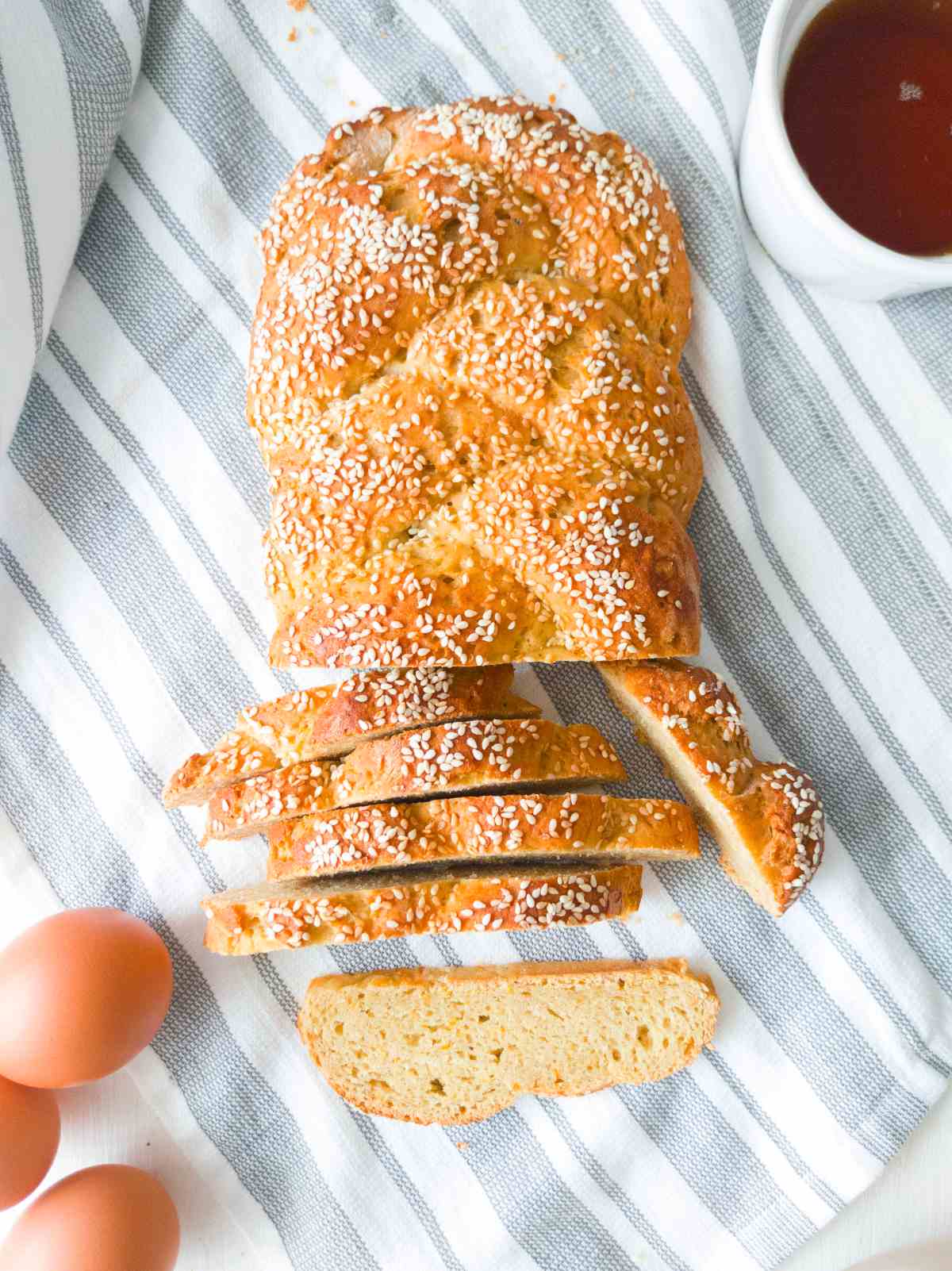
Jump to:
What Is Tsoureki?
Tsoureki is Greek Easter bread that is rich because of the egg, milk, and butter. This sweet braided bread is eaten in many other countries as well during Easter time!
Sometimes you will see a red egg (kokkina avga) baked into the braid and sometimes this brioche bread will be simply topped with sesame seeds, poppy seeds, or almond flakes!
This delicious bread has a unique flavor added by lemon and orange zest along with mastiha and mahlepi (traditional spices used for this type of bread). In this recipe, I am using cardamom in place of mahlepi and vanilla to substitute for mastiha!
Ingredients
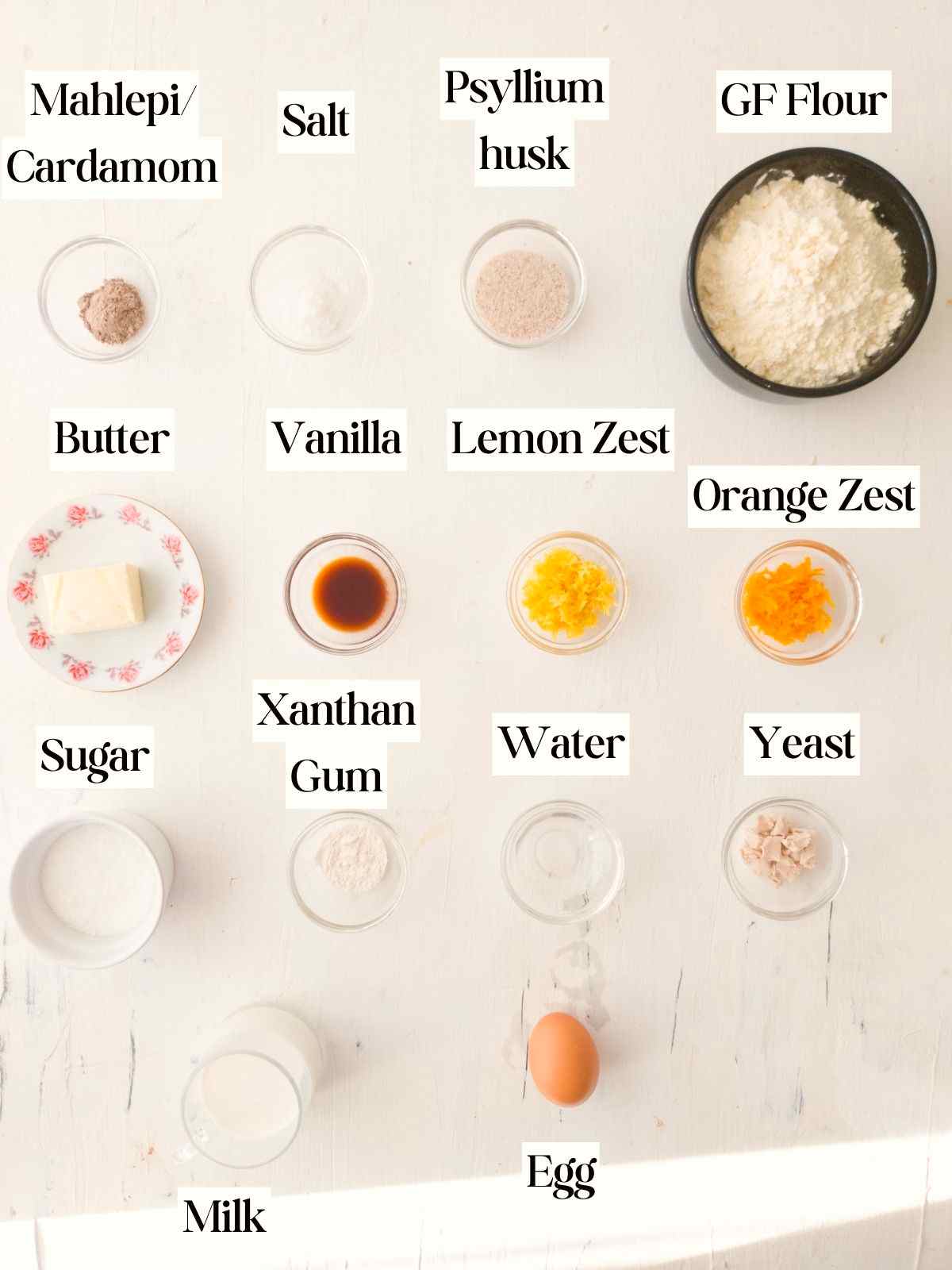
Mahlepi - I don't have mahlepi anywhere in my town, so I chose cardamom as a substitute.
Mastiha - the same story as with mahlepi, I simply don't have access to it, so I chose vanilla as a substitute.
Psyllium husk - use whole husks or coarsely ground powder. If you are using finely ground powder, use 7g instead of 10g. Check out my psyllium husk guide for more details!
Gluten-free flour - I tested this recipe multiple times using my homemade blend with millet flour but this recipe should work with any other premade blend. You might only need to adjust the amount if your bread comes out gummy.
Xanthan gum - this ingredient is necessary to create a strong texture for braiding and avoid a dense crumb psyllium husk would create if we used it alone.
Yeast - use any kind of yeast. I use fresh yeast simply because it is the strongest type!
Substitutes
Vegan Version
Use plant-based milk, oil in place of butter, and ¼ cup of applesauce to substitute the egg!
Dairy-Free Version
Use plant-based milk and oil in place of butter.
Gum-Free Version
Without xanthan gum, you won't be able to braid your bread so I recommend using a silicone braided bread pan to make your gluten-free tsoureki look authentic!
Yeast-Free Version
You can make gluten-free tsoureki with sourdough instead of instant yeast if you need to. To do that follow my gluten-free sourdough challah recipe and add mahlepi, mastiha, lemon, and orange zest.
Step-By-Step Instructions
Step 1 - Mix the dough
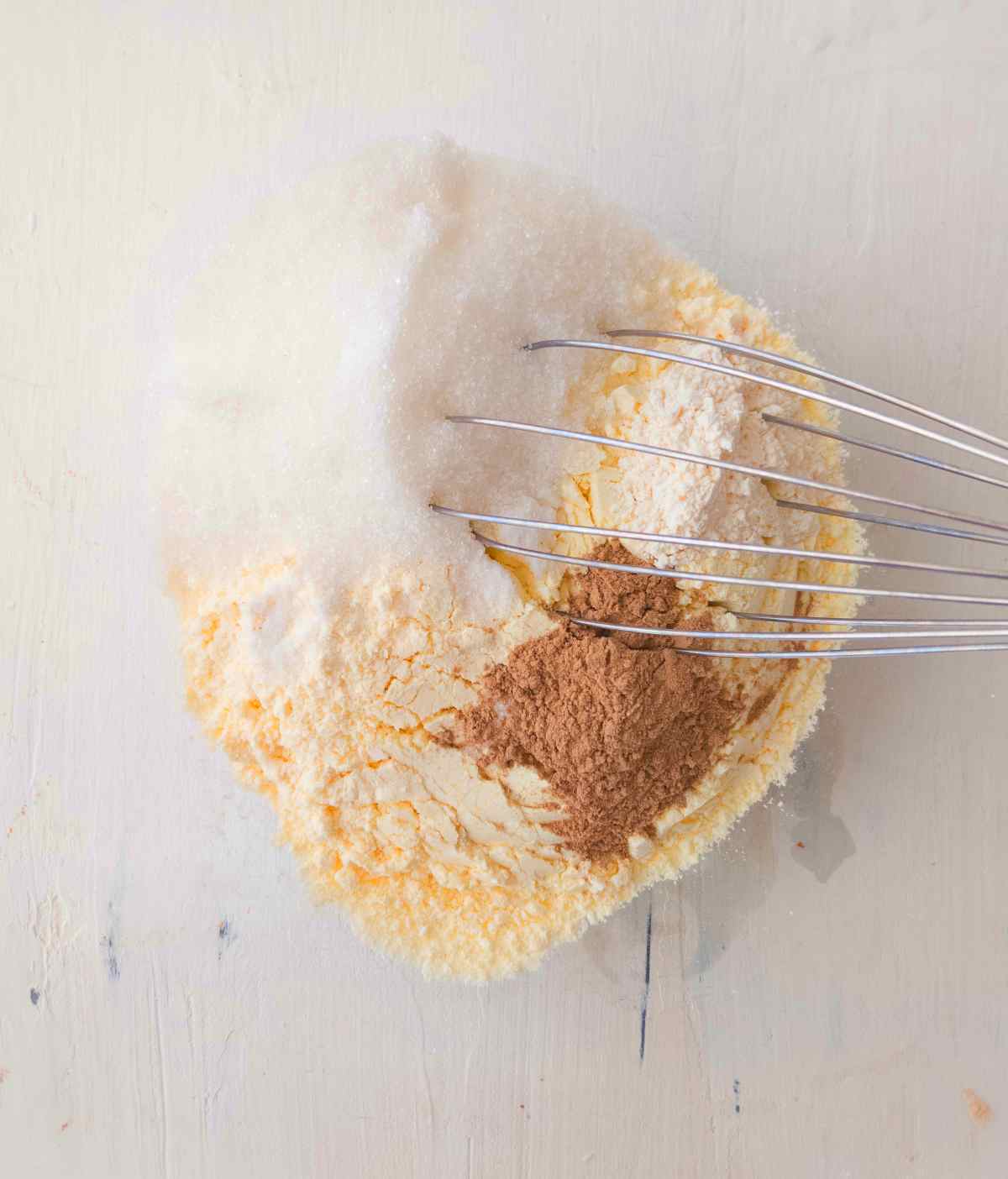
Combine all the dry ingredients in a large mixing bowl.

Add milk, water, and psyllium husk to a small bowl and whisk to combine. Leave for 1-2 minutes to thicken and form a gel.
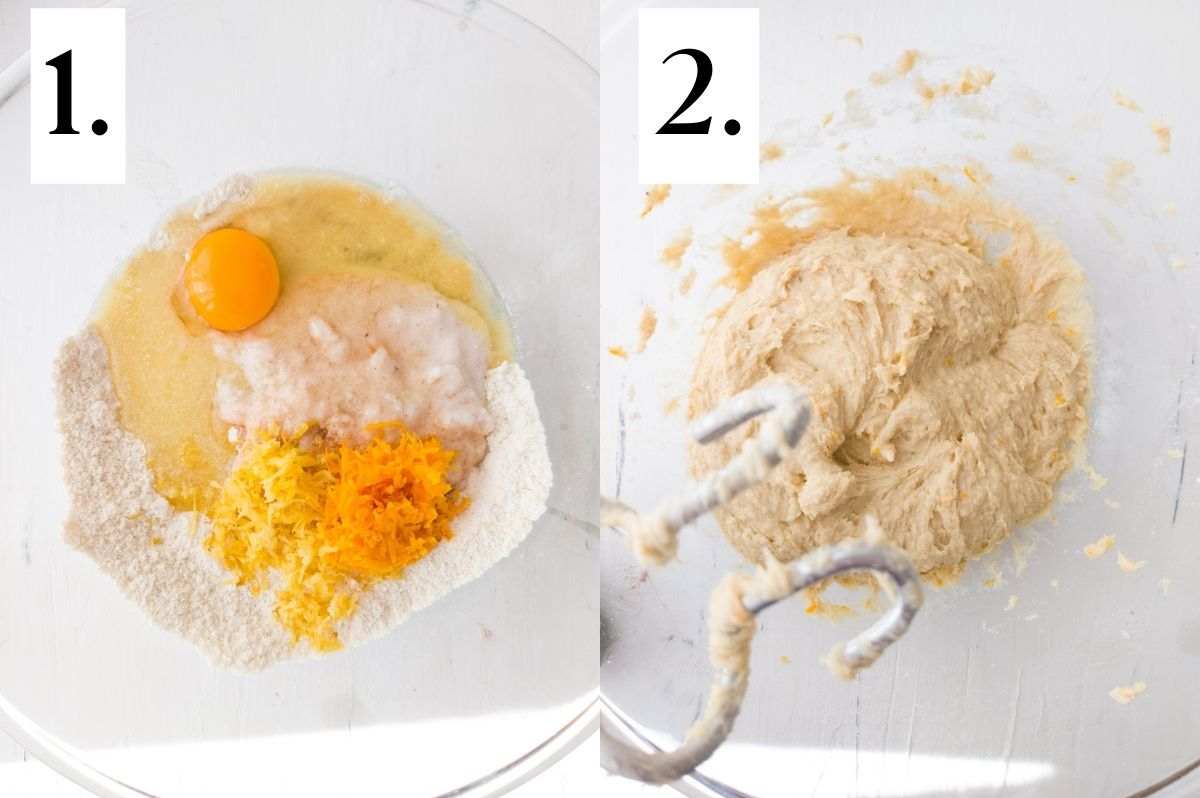
Melt the butter in the microwave and let it cool a little bit. Once psyllium gel has formed, add all of the ingredients to the bowl with the dry ingredients and knead with a hand mixer or in a stand mixer for 5 minutes. If you are kneading by hand, knead for 10 minutes to ensure a smooth dough without lumps. Cover the dough with a kitchen towel and place it into the refrigerator for the first rise (2-12 hours).
The reason for placing it into the fridge is to allow extra time for the dough to set and to make the dough easier to handle.
Step 3 - Braid the bread
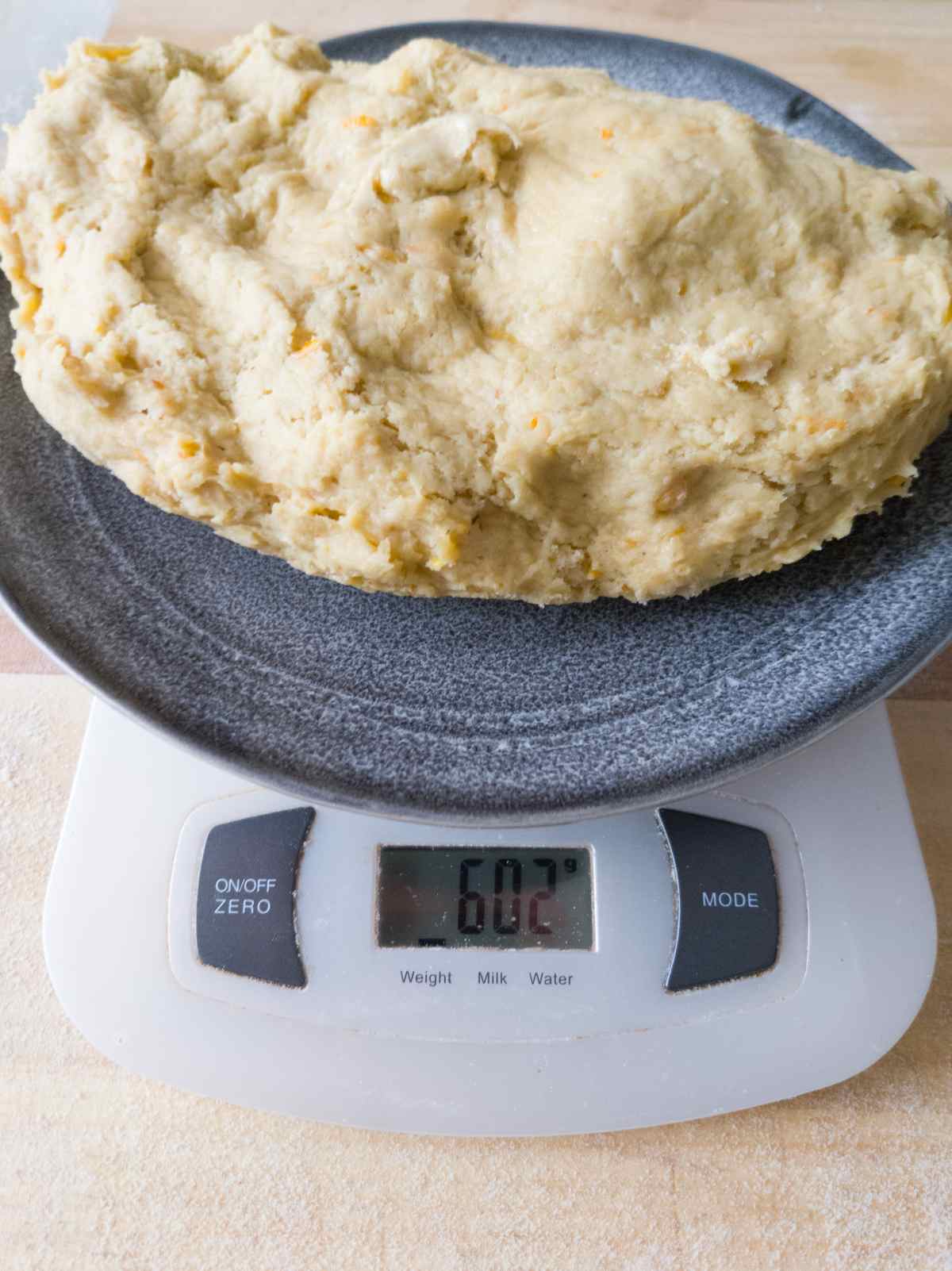
Take the dough out of the refrigerator, grease your hands, and weigh the dough. Then, split it into three equal parts (use a digital scale).
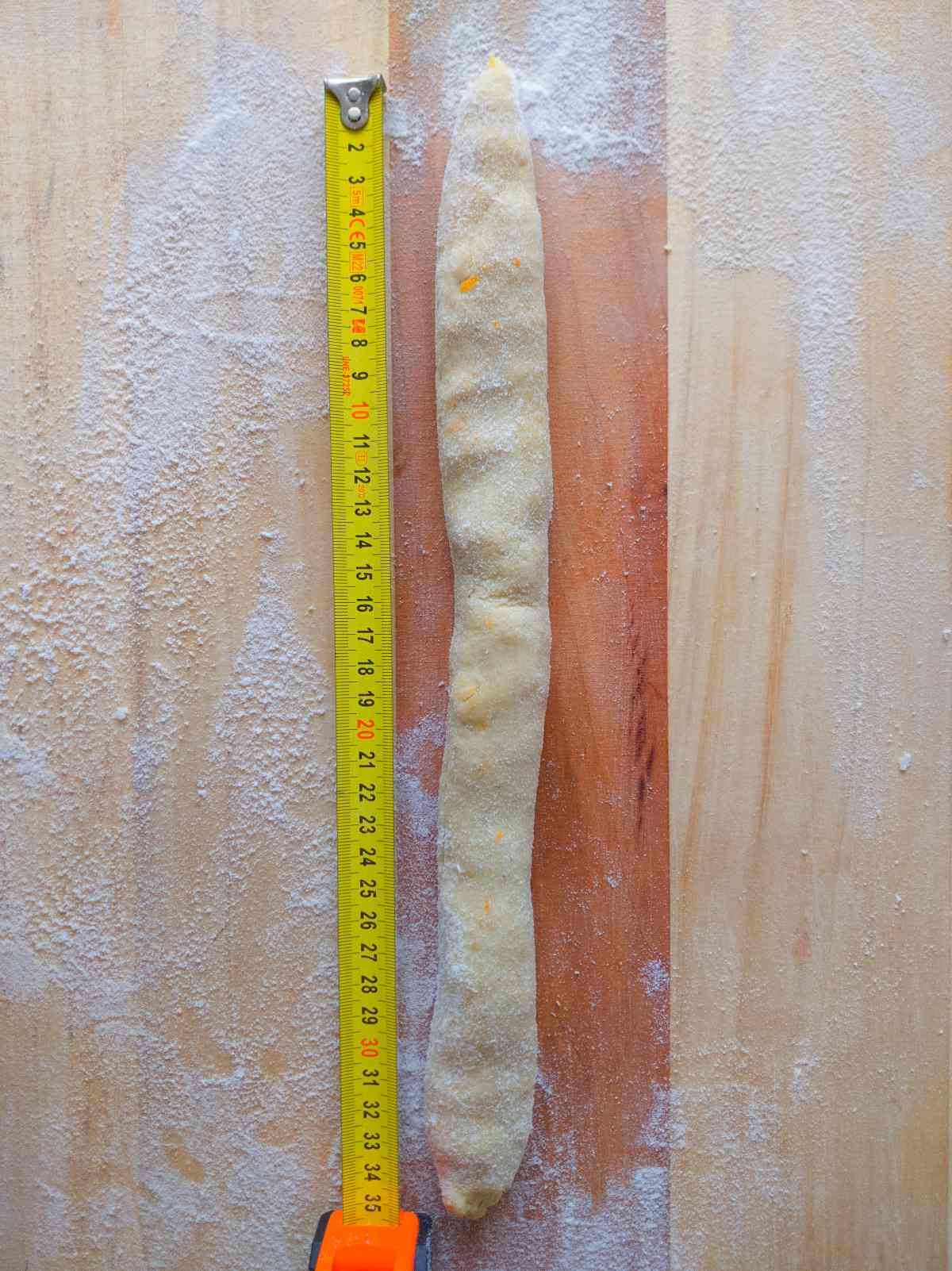
Then, flour the working surface. I prefer using a wooden surface as it is easier to flour evenly! Take one of the dough parts and roll it in the flour that is already on the working surface.
Start rolling the dough into a long sausage using your hands. One part should be about 35cm/14 inches. Don't spread it too thin as the dough might break during braiding if it is too thin.
If the dough starts sticking just add more flour.
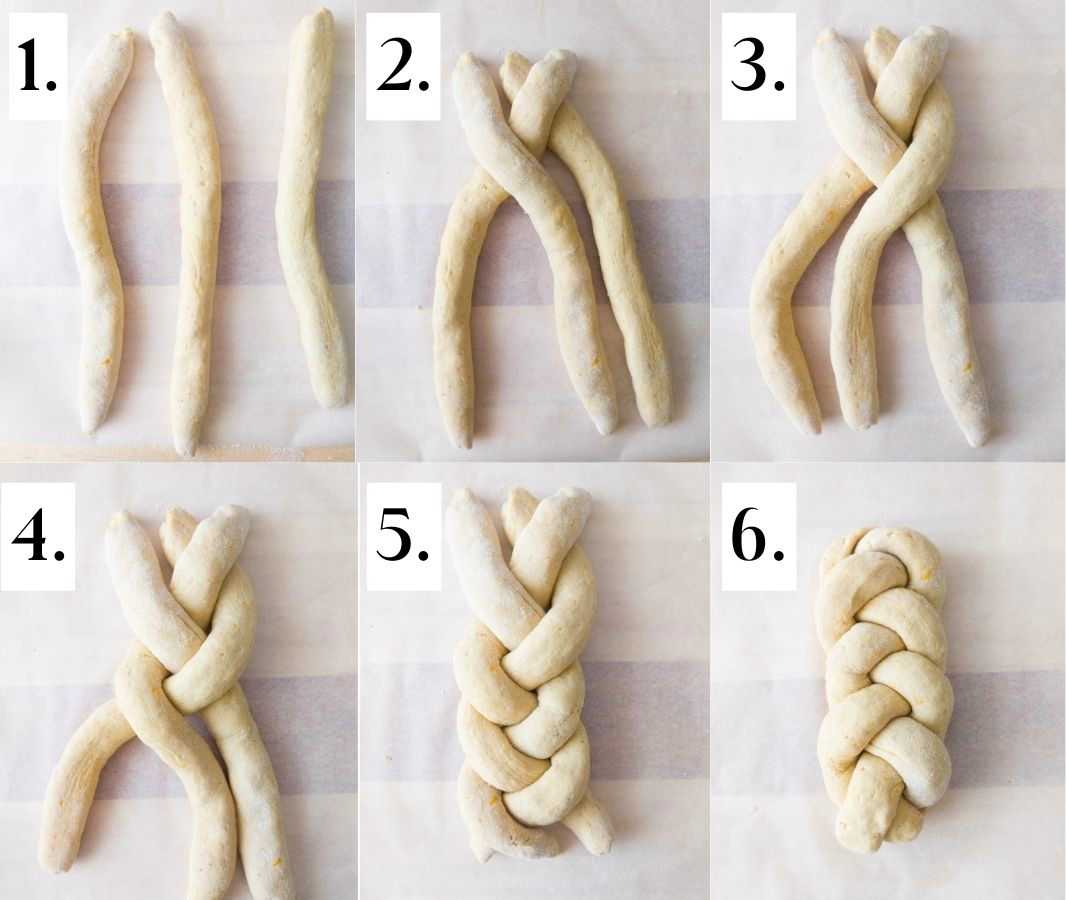
When all three parts are ready, roll them onto a piece of parchment paper, don't lift them as they are very fragile at this point. Then, place them next to each other and start braiding.
Take the right strand and place it over the middle one, then place the left one over the one that is now in the middle, then the right one, etc. Make sure to lift the whole strand as you braid to avoid them stretching.
Now, cover the braided tsoureki bread with a tea towel and let it rise for 45-60 minutes at room temperature. 15-20 minutes until the rising time is over, start preheating your oven to 350F/175C.
Place a large dish with water in the bottom of the oven to create extra steam that will help both raise the bread and prevent it from browning too soon!
Step 3 - Bake
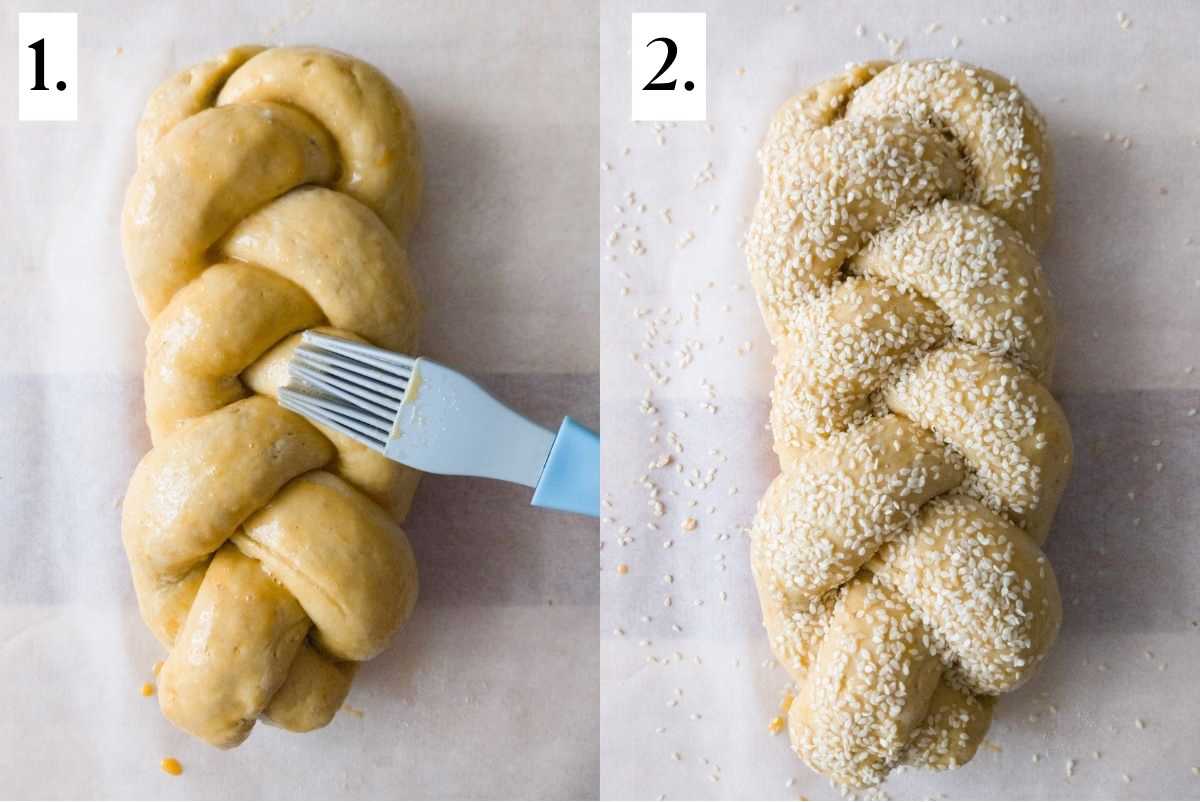
To prepare the egg wash just whisk one egg in a small bowl using a fork. Then, brush the tsoureki bread with it and top it with sesame seeds (poppy seeds or almond flakes work, too!).
Carefully transfer the baking paper onto a rimmed baking tray, cover it with foil to prevent browning too soon, and bake for 30 minutes at 350F/175C. Then, remove the foil, lower the temperature to 325F/150C, and continue baking for additional 30 minutes (keep checking the bread in the last 10 minutes).
You know the bread is ready if a toothpick comes out without too much raw dough sticking to it. If the bread has browned too much and is not baked yet, cover it with foil again and finish baking. Transfer the bread onto a cooling rack when ready, and wait until cooled completely before slicing into it!
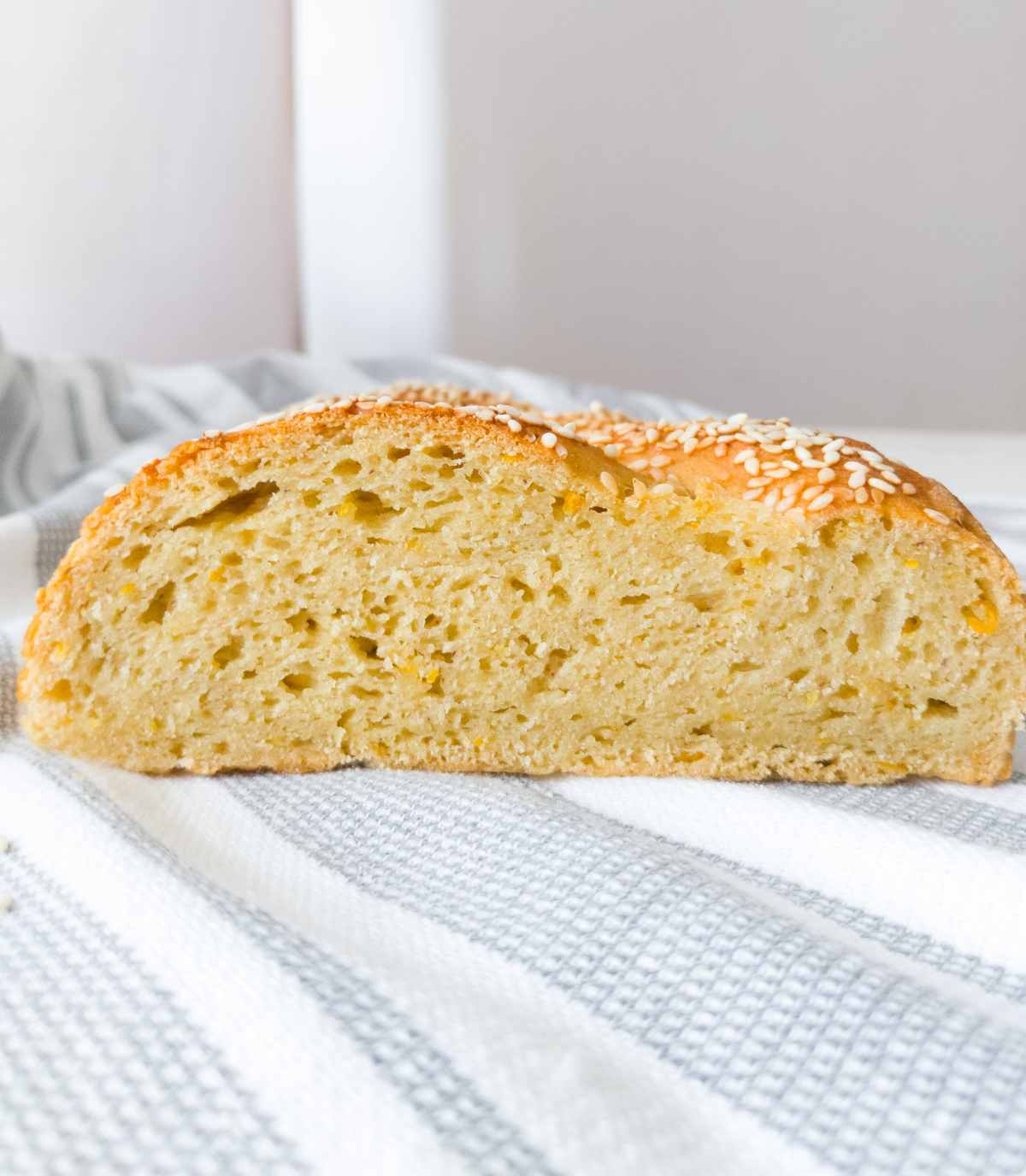
Expert Tips
- Don't skip any steps, follow the recipe exactly as is. I tested this recipe multiple times and found the perfect balance between liquids and flour to create a soft, yet not gummy texture!
- If the dough is too sticky, use more flour as you are rolling it. Don't mix any additional flour into the dough!
- Lift the whole strand of dough when you braid to prevent stretching/breaking.
- When transferring the paper with the bread on it to the baking rack, hold the paper at the ends of the bread. If you hold the paper at the sides of the bread, it can fall. I have had that happen to me!
FAQ
It could be due to using a different type of flour or not baking long enough. If you are using a different flour, try adding a little bit more next time.
Yes, you can slice and freeze this tsoureki bread. Keep it in a freezer bag or an air-tight container for up to 3 months. You can keep tsoureki in the refrigerator for 3-4 days and 2-3 days at room temperature.
More like this

Get my new
Gluten-Free Bread Recipes eBook
The top 7 recipes of 2024!
📖 Recipe
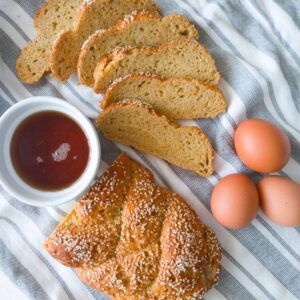
The Best Gluten-Free Tsoureki
Equipment
Ingredients
- 250 grams (1⅔ cups) gluten-free flour I used my homemade blend with millet flour (102g millet flour, 35g sorghum flour, 75g cornstarch, 38g tapioca starch)
- 75 grams (⅔ cup) sugar
- ½ tbsp xanthan gum refer substitutes section for the gum-free version
- ½ teaspoon salt
- 1 teaspoon cardamom or mahlepi
- 10 grams psyllium husk whole husks, not powder, refer to the psyllium husk guide for details
- ½ cup (120g) milk room temperature, can use plant-based milk
- 1 tablespoon water room temperature
- 7 grams dry active yeast/instant yeast or 10g of fresh yeast
- 50 grams (3½ tbsp) butter melted, can use oil for dairy-free
- 2 teaspoon vanilla or mastiha
- zest of 1 orange
- zest of 1 lemon
- 1 egg at room temperature
You Will Also Need
- 1 egg for egg wash
- sesame seeds for topping
Instructions
Mix the dough
- Combine all the dry ingredients in a large mixing bowl.
- Add milk, water, and psyllium husk to a small bowl and whisk to combine. Leave for 1-2 minutes to thicken and form a gel.
- Melt the butter in the microwave and let it cool a little bit. Once psyllium gel has formed, add all of the ingredients to the bowl with the dry ingredients and knead with a hand mixer or in a stand mixer for 5 minutes. If you are kneading by hand, knead for 10 minutes to ensure a smooth dough without lumps. Cover the dough with a kitchen towel and place it into the refrigerator for the first rise (2-12 hours).
- The reason for placing it into the fridge is to allow extra time for the dough to set and to make the dough easier to handle.
Braid the bread
- Take the dough out of the refrigerator, grease your hands, and weigh the dough. Then, split it into three equal parts (use a digital scale).
- Then, flour the working surface. I prefer using a wooden surface as it is easier to flour evenly! Take one of the dough parts and roll it in the flour that is already on the working surface. Start rolling the dough into a long sausage using your hands. One part should be about 35cm/14 inches. Don't spread it too thin as the dough might break during braiding if it is too thin.
- If the dough starts sticking just add more flour.
- When all three parts are ready, roll them onto a piece of parchment paper, don't lift them as they are very fragile at this point. Then, place them next to each other and start braiding. Take the right strand and place it over the middle one, then place the left one over the one that is now in the middle, then the right one, etc. Make sure to lift the whole strand as you braid to avoid them stretching.
- Now, cover the braided tsoureki bread with a tea towel and let it rise for 45-60 minutes at room temperature. 15-20 minutes until the rising time is over, start preheating your oven to 350F/175C. Place a large dish with water in the bottom of the oven to create extra steam that will help both raise the bread and prevent it from browning too soon!
Bake
- To prepare the egg wash just whisk one egg in a small bowl using a fork. Then, brush the tsoureki bread with it and top it with sesame seeds (poppy seeds or almond flakes work, too!). Carefully transfer the baking paper onto a rimmed baking tray, cover it with foil to prevent browning too soon, and bake for 30 minutes at 350F/175C. Then, remove the foil, lower the temperature to 325F/150C, and continue baking for additional 30 minutes (keep checking the bread in the last 10 minutes).
- You know the bread is ready if a toothpick comes out without too much raw dough sticking to it. If the bread has browned too much and is not baked yet, cover it with foil again and finish baking. Transfer the bread onto a cooling rack when ready, and wait until cooled completely before slicing into it!


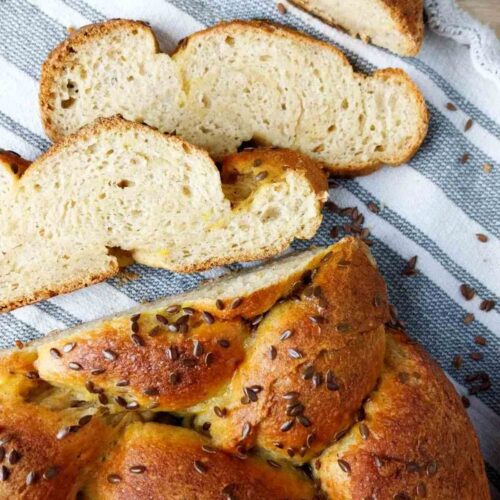
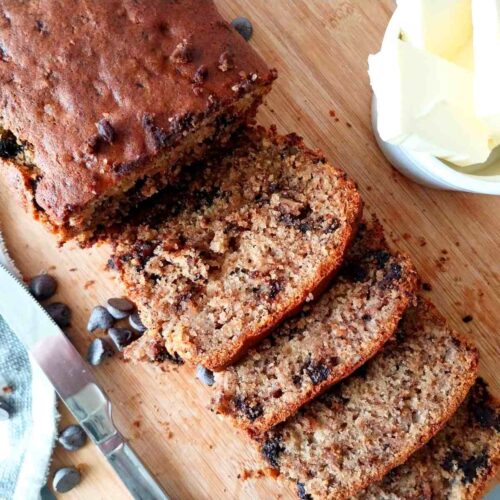


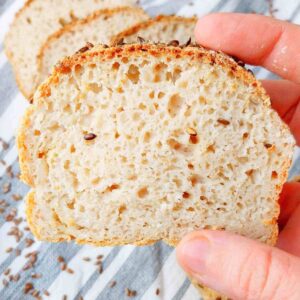

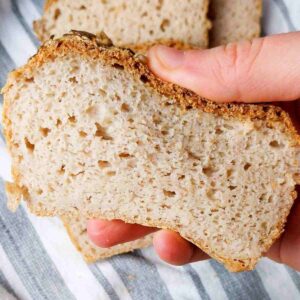
Olivia
In the recipe step by step pictures it shows an egg involved in the mixture of the dough but it is never stated in the directions. Do I add an egg to the dough or just the egg wash?
Natashashome
Hi Olivia! Thank you so much for your question. Yes, you should add the egg to the dough. I will edit the recipe card to make it clear!